
By Doug Winter – RareGoldCoins.com ……
CoinWeek Content Partner ……
Over the last decade, I have become more and more interested in low-grade examples of No Motto San Francisco gold. By “low grade”, I mean coins in the AG3 to VF35 range, and by “No Motto” I am referring to the Liberty Head design type produced at the San Francisco Mint from 1854 (the year this facility opened) through 1866 when the motto IN GOD WE TRUST was added.
For this study, I am going to focus solely on half eagles and eagles. These were the workhorse denominations from this mint and appear to have been used more in local commerce than the smaller denominations ($1.00, $2.50, and $3.00), and the large-size double eagle.
In my experience, the circulation pattern of San Francisco gold changes around 1879 when mintages increase dramatically for half eagles and eagles but the coins are no longer extensively used in commerce as they are replaced by silver dollars and paper money. In addition, many of the San Francisco half eagles from the 1880s, ’90s, and early 1900s are never released into circulation but are instead sent overseas for foreign trade payments.
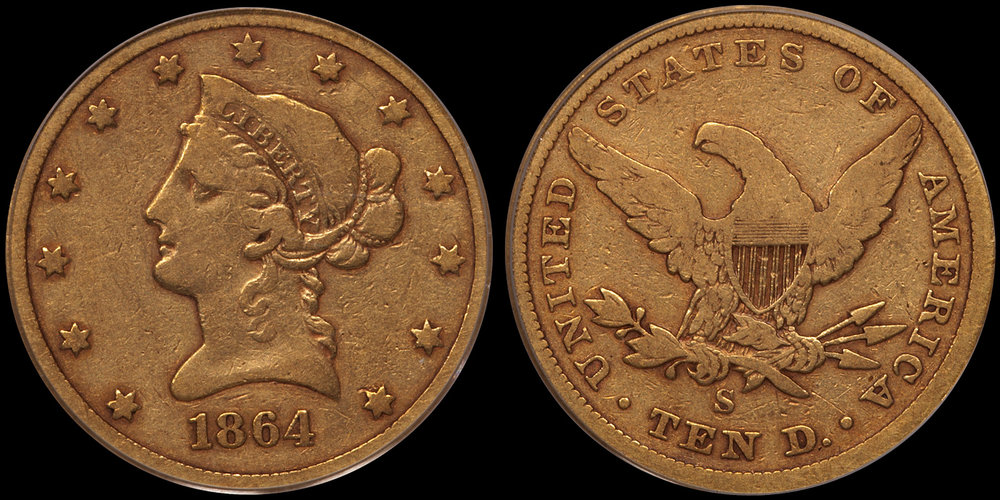
1864-S $10.00 PCGS VG10 CAC Gold Sticker, Old Green Holder. Images courtesy Douglas Winter Numismatics
The impetus behind this article was a nice PCGS VG10 1864-S eagle that I recently handled. As I was writing this coin up, I got to thinking about the uncommonly large number of very-low-grade examples of this date that I have handled. There are only 30 to 40 1864-S eagles known in all grades, but in the last five years I’ve handled no less than seven – including six graded between Very Good and Choice Very Fine.
Was this an anomaly?
How did the number of very-low-grade 1864-S eagles compare as a percentage of the total known in all grades to other dates from this era? Was it possible that foresighted numismatists and bankers from the 1920s and ’30s pulled these low-grade SF eagles (and half eagles) out of the melt piles, knowing they were scarce, low-mintage issues?
First, let’s take a look at the 13 No Motto San Francisco half eagles produced between 1854 and 1866.
SAN FRANCISCO NO MOTTO HALF EAGLES, 1854-1866
Here are some observations about lower-grade San Francisco half eagles, based in part on the numbers above and also on my personal findings from years of specializing in rare-date gold.
The total percentage of coins graded VF35 and lower is 30.38 but these numbers are skewed by the common 1855-S, 1856-S, and 1857-S, which together make up 551 of the 994 coins graded in total. If we eliminate these three issues, then we’re left with 197 San Francisco half eagles of this type graded VF35 and lower (35.75%).
I find it interesting that the percentage of coins grading VF35 and lower begins to rise around 1860. For the seven issues struck between 1860 and 1866, the total number of coins graded VF35 or lower is 173 out of a total number of 355 graded, or 48.73%. With nearly half the total coins graded in VF35 and below, this is a significant percentage.
Two dates really stand out to me based on these numbers.
The first is the very rare 1864-S, which has 10 of 17 PCGS grading events recorded as VF35 or lower. This doesn’t surprise me as this coin has been recognized as rare at least as far back as the 1900s/1910s, and it has a low-enough mintage that non-numismatists with access to a basic coin guide could easily determine that the 1864-S half eagle was a special coin, even in very low grades.
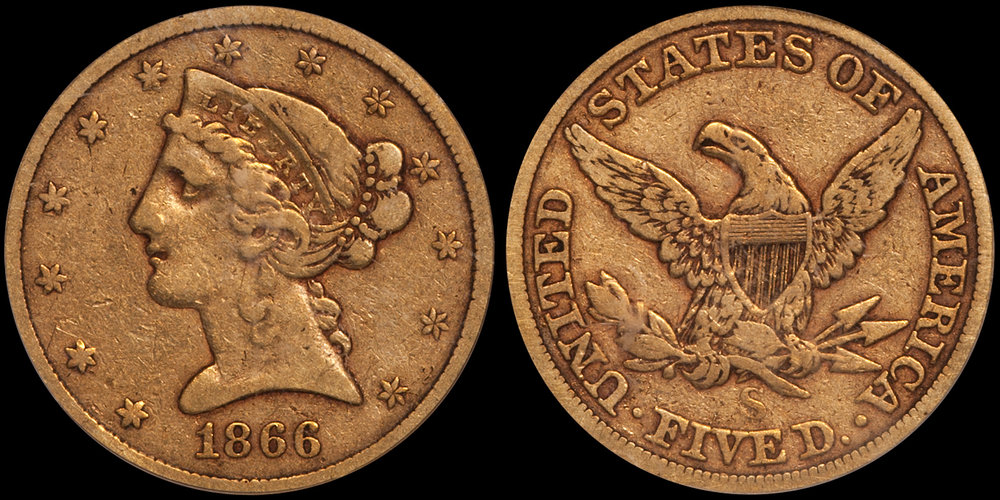
1866-S NO MOTTO $5.00 PCGS VF20 CAC
The date that surprised me is the 1866-S No Motto, which had 45 of 74 coins in lower grades, or 60.81%. I’m going to make an assumption that the rarity of this date was not widely known as early as that of the 1864-S. In fact, I’d be surprised if the 1866-S No Motto was recognized as a rarity much before the 1940s – long after many had been melted. Why did so many lower-grade pieces survive? Did someone make an effort to save these? We may never know the answer.
Now, let’s move on to the No Motto eagles struck from 1854 through 1866. This denomination has a total of 14 issues due to the fact that there are two varieties of 1865-S eagle: the Normal Date and the Inverted Date.
SAN FRANCISCO NO MOTTO EAGLES, 1854-1866
A total of 20.84% of the No Motto eagles from San Francisco graded by PCGS are in VF35 and lower. This percentage is clearly skewed by the relatively common 1854-S and the 1856-S. If we eliminate these two dates, we have a total of 182 coins in lower grades out of a total of 554 or 32.85%, which is much more in line with the half eagles of this design. The 1854-S is an issue with an uncommonly high mintage figure for this type/mint and it is a known fact that examples were shipped to foreign banks where they were well preserved. This is also true with the 1856-S, although not to the extent of the 1854-S.
The 1857-S has a low percentage of survivors in lower grades (12/80 or just 15%). This is due to the fact that a small but significant number of higher-grade pieces have come onto the market from the SS Central America shipwreck.
I find it interesting that the three rarest dates of this type (1864-S, 1865-S Normal Date, and 1866-S No Motto) have the highest percentage of the total known in lower grades. One would expect this from the 1864-S as it has been regarded as a rarity for over a century and it has a low mintage of just 2,500. The 1866-S No Motto is clearly an issue that was saved in lower grades based on the fact that we saw a high percentage of the total known in VF35 or below with the half eagles of this date (see above).
The issue that puzzles me is the 1865-S Normal Date.
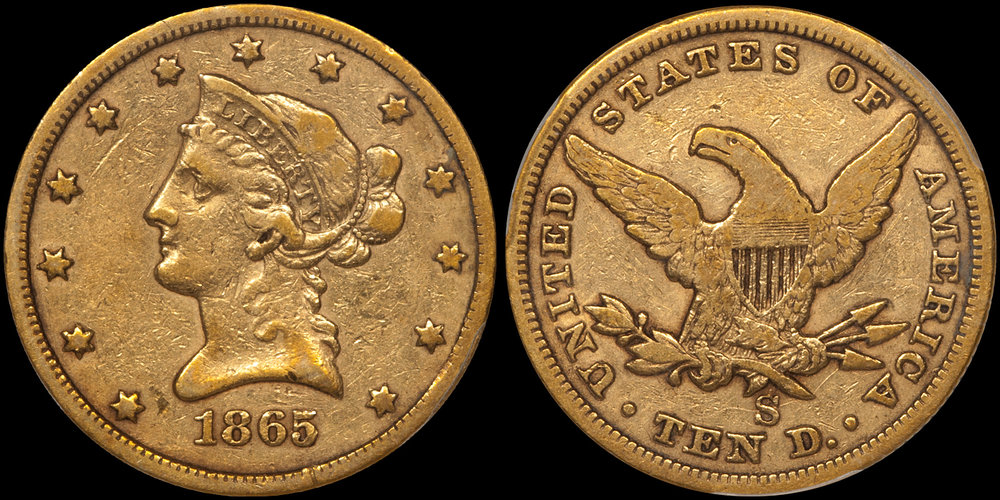
1865-S NORMAL DATE $10.00 PCGS VF25
Even today, few people are aware of the true rarity of this issue and I personally have handled far more 1864-S eagles than I have examples of this variety. Well over 50% of the examples graded by PCGS are in VF35 and below. How did this happen? Did some foresighted dealer or banker pluck these from circulation or from melt piles before they were destroyed, avoiding the fate encountered by a large percentage of the total known for this issue?
Given the fact that $10 was a lot of money back in the 1850s and ’60s, it seems pretty obvious that these coins wouldn’t circulate with the same velocity as a half eagle. While $5 was not an insignificant sum in that era, transactions involving half eagles clearly occurred more often than they did with eagles. This is, obviously, why we see more very-low-grade half eagles than eagles from the time period.
Collectors who can’t afford high-grade No Motto half eagles and eagles from San Francisco are fortunate that there is a decent number of pleasing lower-grade coins available. With higher-grade examples of the rarer dates often costing in excess of $20,000-30,000, it’s nice to know that there are options at lower price points. These well-worn San Francisco half eagles and eagles are historically significant coins that are finally being well-appreciated by collectors.
Do you want to collect lower grade No Motto San Francisco half eagles and/or eagles? DWN often stocks pleasing PCGS graded examples (many with CAC approval) and they tend to sell quickly to appreciative numismatists. Let’s chat today if you’d like to begin a specialized collection of these coins! You can reach me via email at [email protected] or by phone at (214) 675-9897.
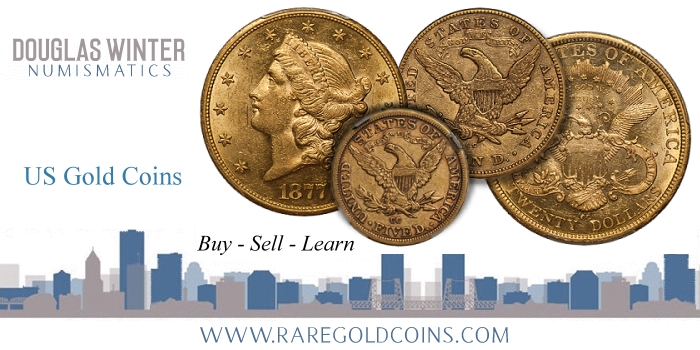
* * *
About Doug Winter
 Doug has spent much of his life in the field of numismatics; beginning collecting coins at the age of seven, and by the time he was 10 years old, buying and selling coins at conventions in the New York City area.
Doug has spent much of his life in the field of numismatics; beginning collecting coins at the age of seven, and by the time he was 10 years old, buying and selling coins at conventions in the New York City area.
In 1989, he founded Douglas Winter Numismatics, and his firm specializes in buying and selling choice and rare United States coins, especially US gold coins and all branch mint material.
Recognized as one of the leading specialized numismatic firms, Doug is an award-winning author of over a dozen numismatic books and the recognized expert on US Gold. His knowledge and exceptional eye for properly graded and original coins has made him one of the most respected figures in the numismatic community and a sought after dealer by collectors and investors looking for professional personalized service, a select inventory of impeccable quality and fair and honest pricing. Doug is also a major buyer of all US coins and is always looking to purchase collections both large and small. He can be reached at (214) 675-9897.
Doug has been a contributor to the Guidebook of United States Coins (also known as the “Redbook”) since 1983, Walter Breen’s Encyclopedia of United States and Colonial Coins, Q. David Bowers’ Encyclopedia of United States Silver Dollars and Andrew Pollock’s United States Pattern and Related Issues
In addition, he has authored 13 books on US Gold coins including:
- Gold Coins of the New Orleans Mint: 1839-1909
- Gold Coins of the Carson City Mint: 1870 – 1893
- Gold Coins of the Charlotte Mint: 1838-1861
- Gold Coins of the Dahlonega Mint 1838-1861
- The United States $3 Gold Pieces 1854-1889
- Carson City Gold Coinage 1870-1893: A Rarity and Condition Census Update
- An Insider’s Guide to Collecting Type One Double Eagles
- The Connoisseur’s Guide to United States Gold Coins
- A Collector’s Guide To Indian Head Quarter Eagles
- The Acadiana Collection of New Orleans Coinage
- Type Three Double Eagles, 1877-1907: A Numismatic History and Analysis
- Gold Coins of the Dahlonega Mint, 1838-1861: A Numismatic History and Analysis
- Type Two Double Eagles, 1866-1876: A Numismatic History and Analysis
Finally, Doug is a member of virtually every major numismatic organization, professional trade group and major coin association in the US.


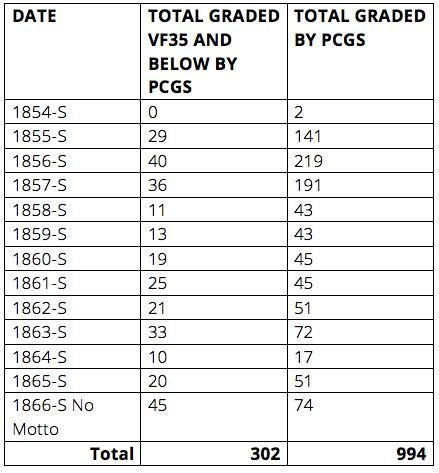
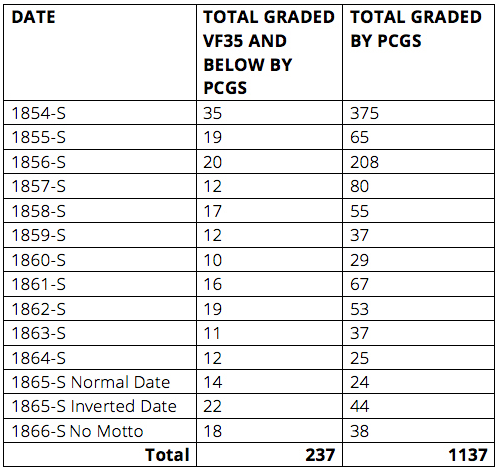



The list of known uncirculated examples of half eagles after the paragraph “First, let’s take a look at the 13 No Motto San Francisco half eagles produced between 1854 and 1866.” Shows the amount of surviving uncirculated New Orleans Mint half eagles, where I believe you intended to put no motto San Francisco Mint half eagles.
Thank you for letting us know! It has been corrected.
I still insist that Dahlonega sounds like a town with a NASCAR race track. “Welcome, racing fans, to the Dahlonega 400…”
I hear Talladega Mint gold coins are extremely rare and highly sought after…